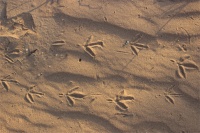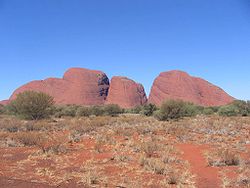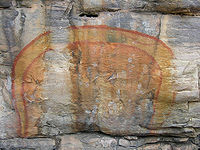IND/Dreaming Stories
Dreaming stories contain knowledge as well as a guide to living.
The most common interaction most Australians have with The Dreaming is by reading Dreaming stories. The word “stories” in English can convey “made up” and “fictional”; something that does not carry the weight of “fact” or “truth”. This is not the way to think of Dreaming Stories. Indigenous culture turns on knowledge, and access to knowledge is carefully controlled. A person needs to show they are capable and responsible before they can be taught the next level of knowledge. Often this progression is publicly acknowledged through initiation ceremonies. The older you were the more you learnt that was relevant to your survival.
Your understanding of Dreaming Stories is likely to be at the level of “story”. It may be out of context and unrelated to its place in its Dreaming cosmology. It is also likely that for some Indigenous people, especially those who were taken as children, Dreaming stories also remain without full context.
A Wiradjuri Dreaming story
Read the following story and see the list of some life lessons you can find in the story.
Wirroowaa and the Giant Kangaroos
Long ago, many people were camped at the place where the Lachlan and Murrumbidgee rivers meet. The day was very hot and a haze rose from the windless plain so that the horizon danced, and mirages distorted the landscape. Everyone lay motionless, resting in the heat. Suddenly, a tribe of giant kangaroos were seen away in the distance and the headman leapt to his feet with a cry. The camp became a scene of wild excitement and fear. Children were quickly seized and everyone dispersed into the bush. In those times, however the men had no weapons and were defenceless against the enemy. The kangaroos relentlessly advanced on them through the bush and without mercy crushed their victims with powerful arms. When the animals were finished, few of the tribe remained. The headman, however, lived, and in desperation he called the remaining band tighter to discuss methods of defence. At the meeting the men devised the weapons of spears, shields, clubs and boomerangs. Many young women had lost their children as they fled, and needing a device in which to carry their babies they made the bark cradle.
But Wirroowaa, the cleverest of the men, thought of enlisting the help of the Great Spirit. To do this, however, he needed to paint his chest with sacred designs in white clay which had to be collected from the banks of the river bed where the giant kangaroos were camped. Fearlessly he set out across the plain for the river bed; He turned over a hollow log with his foot and found a big, brow-banded goanna. Quickly killing the goanna, Wirroowaa slit the belly open with a stone and extracted the body fat. This he smeared all over his skin until it glistened in the hot sun; then he rolled in the dust until he was brown as the earth, and then he picked up a branch of leaves to hold before him.. Completely disguised he quietly crept on towards the Kangaroo camp and without being observed stole the sacred clay.
Behind him a small breeze had come up, and the nearer he got to the river bed the stronger the breeze became. Two sticks which first were gently rubbing together soon became warm, then red hot, and suddenly a spark flew from the smoking twigs into a patch of dry grass. A fire was made. Wirroowaa quickly smeared his body with the clay, making designs which would bring the presence of the Great Spirit to him.
The wind gradually grew in volume and spread over the grassy plain. The little breeze became a gale. The Great Spirit came and told Wirroowaa to keep to the dry patches of ground. The giant kangaroos appeared on the horizon but were driven back immediately by the fire. Each man must now carry spears, clubs and bark must be stripped from the trees to make shelters for each family, so that the sun would not weaken the people as it had in the past.
Some life lessons you can learn from this story:
- Danger of animals
- Map
- Use of white clay
- Camouflage
- How to catch a goanna
- War tactics
- Development of tools and weapons
- How to make fire
- Fire season
- Fire evacuation
- Role of men and women
- Firestick farming / controlled burning
An Awabakal Dreaming story
Your turn: Read the following story from the Newcastle area. List any life lessons you can identify.
Note, a 5.6 magnitude earthquake occurred in Newcastle in 1989 and is considered Australia’s most destructive.
The Kangaroo That Lives Inside Nobbys
A very long time ago, when there were still giant sized animals around, all the various animals within the area would separate into two groups – one group being the females and the other the males. They all lived together very peacefully and happily.
One day a large male kangaroo attacked a female wallaby. This was against the law.
He was banished from the kangaroo group forever. After a long chase by the wallabies the kangaroo reached Muloobinba, the place of the sea ferns, now called Newcastle (the Awabakal language nation).
As he entered the sea, he thought about how lucky he was to be able to slip away from the wallabies that chased him. The wallabies thought that he had drowned.
But the kangaroo had swum to Nobbys Island and entered the tall rocky outcrop, making sure that he was out of sight of everyone.
He is still there to this day, but he won’t come out because he is never sure if it is safe for him from the angry wallabies. Sometimes he gets upset and jumps around inside his prison. When his giant tail crashes against the earth, it makes the rocks fall and the ground tremble.
What is the Dreaming?
Visit the following websites and look at some of the Dreaming stories illustrated there. Choose one to explore in more detail.
- http://www.abc.net.au/dustechoes/dustEchoesFlash.htm
- http://www.infotech.monash.edu.au/research/projects/independent/countrylines-archive/animations/
Write a short (3-5 sentence) paragraph which provides an overview of the Dreaming and link it to some important life lessons found in the Dreaming story you have chosen.


